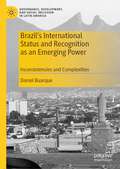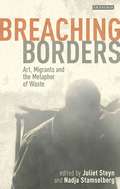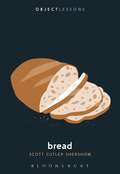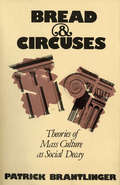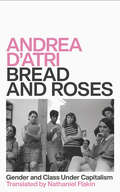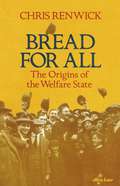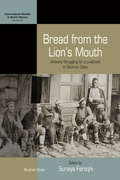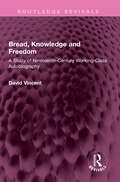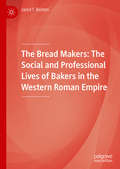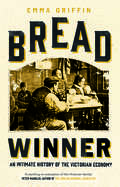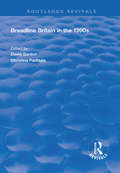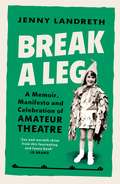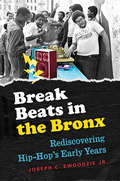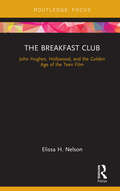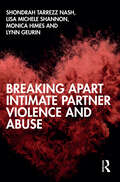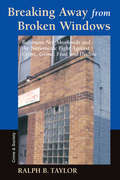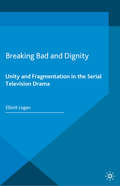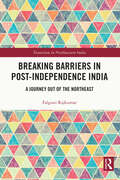- Table View
- List View
Brazil’s International Status and Recognition as an Emerging Power: Inconsistencies and Complexities (Governance, Development, and Social Inclusion in Latin America)
by Daniel BuarqueThis book focusses on the intersubjective character of status in order to understand the degree to which Brazil has been able to achieve an increase in its global status. Buarque compares the long-standing ambitions of Brazilian foreign policy elites with external perspectives of observers in states with greater international status who would need to recognize Brazil as a great power and a state increasing in international prestige. Buarque develops a multidisciplinary approach influenced by sociology and psychology scholarship and gives special attention to the importance of recognition whilst drawing on international relations scholarship focussed on prestige, identity, roles and ontological security. In so doing, the book argues for the difference between the status and role Brazil aspires to have in the world and the external beliefs about the level of prestige of the state, amounting to status inconsistency and anxiety leading to ontological insecurity. It proposes that powerful states perceive Brazil as a coveted pawn in international politics and outlines a typology of what states that aspire to have more prestige need to do to achieve recognition for higher status.
Breaching Borders: Art, Migrants and the Metaphor of Waste (International Library Of Cultural Studies)
by Juliet Steyn Nadja StamselbergIn a 'Europe without borders' that prides itself on multiculturalism while struggling desperately with racism, populated by ghettoized communities, refugee camps and zones of exclusion, two opposing paradigms characterise the discourses of migration: migrants as a problem, a parasite on the nation that disrupts social life, and mobility as the positive goal of modernity, seeking to extend notions of citizenship beyond national boundaries into the realm of universal human rights. This book aims to complicate, provoke and problematize these ubiquitous discourses, evolving new textual and interdisciplinary approaches to European cultural policies and unmasking the assumptions of essentialist identity politics that go undeclared at the borders of cultural discourse. Framed by artworks that provide a glimpse of cross-cultural encounters, 12 contributions by leading figures in post-colonial and translation studies, political philosophy, art, radical aesthetics, policy-making and sociology reflect on the political and cultural meanings of migration. Breaching Borders traces three main themes in exploring the lived reality of European policies of integration: the role of translation in shaping identity construction and enabling the movement of ideas, and art as highlighting symptoms of contemporary malaise, are brought together in the central metaphor of waste - the trail of rubbish left behind by mechanisms of mobility; the excised narratives of wasted identities and people. Beginning with internationally-renowned academic Zygmunt Bauman's contribution on the exclusion and negativing of 'wasted lives' this anthology exposes the contradictions of a Europe that encourages cultural diversities but is obsessed with the perceived threat posed by porous borders.
Bread (Object Lessons)
by Scott Cutler ShershowObject Lessons is a series of short, beautifully designed books about the hidden lives of ordinary things.Bread is an object that is always in process of becoming something else: flower to grain, grain to dough, dough to loaf, loaf to crumb. Bread is also often a figure or vehicle of social cohesion: from the homely image of "breaking bread together†? to the mysteries of the Eucharist. But bread also commonly figures in social conflict - sometimes literally, in the "bread riots†? that punctuate European history, and sometimes figuratively, in the ways bread operates as ethnic, religious or class signifier. Drawing on a wide range of sources, from the scriptures to modern pop culture, Bread tells the story of how this ancient and everyday object serves as a symbol for both social communion and social exclusion.Object Lessons is published in partnership with an essay series in The Atlantic.
Bread (Object Lessons)
by Scott Cutler ShershowObject Lessons is a series of short, beautifully designed books about the hidden lives of ordinary things.Bread is an object that is always in process of becoming something else: flower to grain, grain to dough, dough to loaf, loaf to crumb. Bread is also often a figure or vehicle of social cohesion: from the homely image of “breaking bread together” to the mysteries of the Eucharist. But bread also commonly figures in social conflict - sometimes literally, in the “bread riots” that punctuate European history, and sometimes figuratively, in the ways bread operates as ethnic, religious or class signifier. Drawing on a wide range of sources, from the scriptures to modern pop culture, Bread tells the story of how this ancient and everyday object serves as a symbol for both social communion and social exclusion.Object Lessons is published in partnership with an essay series in The Atlantic.
Bread and Circuses: Theories of Mass Culture As Social Decay
by Patrick BrantlingerLively and well written, Bread and Circuses analyzes theories that have treated mass culture as either a symptom or a cause of social decadence. Discussing many of the most influential and representative theories of mass culture, it ranges widely from Greek and Roman origins, through Marx, Nietzsche, Freud, Ortega y Gasset, T. S. Eliot, and the theorists of the Frankfurt Institute, down to Marshall McLuhan and Daniel Bell, Brantlinger considers the many versions of negative classicism and shows how the belief in the historical inevitability of social decay—a belief today perpetuated by the mass media themselves—has become the dominant view of mass culture in our time. While not defending mass culture in its present form, Brantlinger argues that the view of culture implicit in negative classicism obscures the question of how the media can best be used to help achieve freedom and enlightenment on a truly democratic basis.
Bread and Roses: Gender and Class Under Capitalism
by Andrea D'AtriIs it possible to develop a radical socialist feminism that fights for the emancipation of women and of all humankind? This book is a journey through the history of feminism. Using the concrete struggles of women, the Marxist feminist Andrea D'Atri traces the history of the women's and workers' movement from the French Revolution to Queer Theory. She analyzes the divergent paths feminists have woven for their liberation from oppression and uncovers where they have hit dead ends. With the global working class made up of a disproportionate number of women, women are central in leading the charge for the next revolution and laying down blueprints for an alternative future. D’Atri makes a fiery plea for dismantling capitalist patriarchy.
Bread and Roses: Gender and Class Under Capitalism
by Andrea D'AtriIs it possible to develop a radical socialist feminism that fights for the emancipation of women and of all humankind? This book is a journey through the history of feminism. Using the concrete struggles of women, the Marxist feminist Andrea D'Atri traces the history of the women's and workers' movement from the French Revolution to Queer Theory. She analyzes the divergent paths feminists have woven for their liberation from oppression and uncovers where they have hit dead ends. With the global working class made up of a disproportionate number of women, women are central in leading the charge for the next revolution and laying down blueprints for an alternative future. D’Atri makes a fiery plea for dismantling capitalist patriarchy.
Bread for All: The Origins of the Welfare State
by Chris RenwickSHORTLISTED FOR THE LONGMAN-HISTORY TODAY PRIZE 2018LONGLISTED FOR THE ORWELL PRIZE 2018 'Makes a gripping human story out of the wisest and most progressive policy achievement of any government in the history of the world ... the welfare state deserves books this good' Stuart Maconie, New Statesman, Books of the Year'A brilliant book, full of little revelations' Jon Cruddas, Prospect'Carefully argued, deftly balanced and wittily written, with countless lovely details' Dominic Sandbrook, Sunday TimesA landmark book from a remarkable new historian, on a subject that has never been more important - or imperilledToday, everybody seems to agree that something has gone badly wrong with the British welfare state. In the midst of economic crisis, politicians and commentators talk about benefits as a lifestyle choice, and of 'skivers' living off hard-working 'strivers' as they debate what a welfare state fit for the twenty-first century might look like. This major new history tells the story of one the greatest transformations in British intellectual, social and political life: the creation of the welfare state, from the Victorian workhouse, where you had to be destitute to receive help, to a moment just after the Second World War, when government embraced responsibilities for people's housing, education, health and family life, a commitment that was unimaginable just a century earlier. Though these changes were driven by developments in different and sometimes unexpected currents in British life, they were linked by one over-arching idea: that through rational and purposeful intervention, government can remake society. It was an idea that, during the early twentieth century, came to inspire people across the political spectrum. In exploring this extraordinary transformation, Bread for All explores and challenges our assumptions about what the welfare state was originally for, and the kinds of people who were involved in creating it. In doing so, it asks what the idea continues to mean for us today.
Bread from the Lion's Mouth: Artisans Struggling for a Livelihood in Ottoman Cities (International Studies in Social History #25)
by Suraiya FaroqhiThe newly awakened interest in the lives of craftspeople in Turkey is highlighted in this collection, which uses archival documents to follow Ottoman artisans from the late 15th century to the beginning of the 20th. The authors examine historical changes in the lives of artisans, focusing on the craft organizations (or guilds) that underwent substantial changes over the centuries. The guilds transformed and eventually dissolved as they were increasingly co-opted by modernization and state-building projects, and by the movement of manufacturing to the countryside. In consequence by the 20th century, many artisans had to confront the forces of capitalism and world trade without significant protection, just as the Ottoman Empire was itself in the process of dissolution.
Bread, Knowledge and Freedom: A Study of Nineteenth-Century Working Class Autobiography (Routledge Revivals)
by David VincentFirst published in 1981, Bread, Knowledge and Freedom is a study of 142 working class autobiographies all of which cover some part of the period between 1790 and 1850. It is a full-scale examination of a form of source material that is significantly extensive. The book illustrates many aspects of ordinary working-class family life as well as the working-class pursuit of knowledge and literacy and the attempts of the middle-class educators to impose their notion of ‘useful knowledge.’ Dr. Vincent concludes with an assessment of the contribution of autobiography to nineteenth century working class history. This book will be of interest to students of history, sociology and literature.
Bread, Knowledge and Freedom: A Study of Nineteenth-Century Working Class Autobiography (Routledge Revivals)
by David VincentFirst published in 1981, Bread, Knowledge and Freedom is a study of 142 working class autobiographies all of which cover some part of the period between 1790 and 1850. It is a full-scale examination of a form of source material that is significantly extensive. The book illustrates many aspects of ordinary working-class family life as well as the working-class pursuit of knowledge and literacy and the attempts of the middle-class educators to impose their notion of ‘useful knowledge.’ Dr. Vincent concludes with an assessment of the contribution of autobiography to nineteenth century working class history. This book will be of interest to students of history, sociology and literature.
The Bread Makers: The Social and Professional Lives of Bakers in the Western Roman Empire
by Jared T. BentonBread was the staple of the ancient Mediterranean diet. It was present in the meals of emperors and on the tables of the poorest households. In many instances, a loaf of bread probably constituted an entire meal. As such, bread was both something that unified society and a milieu through which social and ethnic divisions played out. Similarly, bakers were not a monolithic demographic. They served both the rich and the poor, but some bakers clearly operated within regional traditions. Some lived in big cities and others lived in small towns. Some bakers made flat breads and others made leavened loaves. Some made coarse brown loaves and others specialized in fancier white breads. This book offers new methods and new ways of framing bread production in the Roman world to reveal the nuances of an industry that fed an empire. Inscriptions, Roman law, and material remains of Roman-period bakeries are combined to expose the cultural context of bread making, the economic context of commercial baking, the social hierarchy within the workforces of bakeries, and the socio-economic strategies of Roman bakers.
Bread Winner: An Intimate History of the Victorian Economy
by Emma GriffinThe overlooked story of how ordinary women and their husbands managed financially in the Victorian era – and why so many struggled despite increasing national prosperityNineteenth century Britain saw remarkable economic growth and a rise in real wages. But not everyone shared in the nation’s wealth. Unable to earn a sufficient income themselves, working-class women were reliant on the ‘breadwinner wage’ of their husbands. When income failed, or was denied or squandered by errant men, families could be plunged into desperate poverty from which there was no escape.Emma Griffin unlocks the homes of Victorian England to examine the lives – and finances – of the people who lived there. Drawing on over 600 working-class autobiographies, including more than 200 written by women, Bread Winner changes our understanding of daily life in Victorian Britain.
Breadline Britain in the 1990s (Routledge Revivals)
by David Gordon and Christina PantazisFirst published in 1997, this series, published in association with the Social Policy Research Unity at the University of York, is designed to inform public debate about these policy areas and to make the details of important policy-related research more widely available.
Breadline Britain in the 1990s (Routledge Revivals)
by David Gordon Christina PantazisFirst published in 1997, this series, published in association with the Social Policy Research Unity at the University of York, is designed to inform public debate about these policy areas and to make the details of important policy-related research more widely available.
Break a Leg: A memoir, manifesto and celebration of amateur theatre
by Jenny LandrethA joyful celebration of amateur theatreThis is the story of amateur dramatics in Britain. In a triumphant mix of memoir, social history, interviews and manifesto, Jenny Landreth opens our eyes to am-dram and shows us a vibrant world that is a crucial part of our culture. Starting with the Mystery Plays of the Middle Ages, we move, via Shakespeare, to the Georgian aristocrats who built opulent private theatres in their own homes, then to the halcyon days of radical lefties taking political theatre to the streets, and on to the present day. Along the way, we visit several thriving theatres – across the country, and beyond our shores – and meet a cast of characters who tell us about the joy amateur theatre brings them. And we follow the full arc of a production at the Midlands theatre where Jenny's parents met and she started out, from first auditions to last night party, with all the mishaps and forgotten lines that come in between.In Britain today there are millions of people involved, and amateur theatre takes many forms, from classic productions to panto, but also cutting-edge new work. Without it, there would be no professional theatre, no Judi Dench or Kenneth Branagh or Brenda Blethyn. Break a Leg is an emphatic celebration. It is also a rallying cry, a call to appreciate how amateur theatre enriches communities and many people’s lives – and how, if you join in, it might just do the same for you.
Break Beats in the Bronx: Rediscovering Hip-Hop's Early Years
by Joseph C. EwoodzieThe origin story of hip-hop—one that involves Kool Herc DJing a house party on Sedgwick Avenue in the Bronx—has become received wisdom. But Joseph C. Ewoodzie Jr. argues that the full story remains to be told. In vibrant prose, he combines never-before-used archival material with searching questions about the symbolic boundaries that have divided our understanding of the music. In Break Beats in the Bronx, Ewoodzie portrays the creative process that brought about what we now know as hip-hop and shows that the art form was a result of serendipitous events, accidents, calculated successes, and failures that, almost magically, came together. In doing so, he questions the unexamined assumptions about hip-hop's beginnings, including why there are just four traditional elements—DJing, MCing, breaking, and graffiti writing—and not others, why the South Bronx and not any other borough or city is considered the cradle of the form, and which artists besides Kool Herc, Afrika Bambaataa, and Grandmaster Flash founded the genre. Ewoodzie answers these and many other questions about hip-hop's beginnings. Unearthing new evidence, he shows what occurred during the crucial but surprisingly underexamined years between 1975 and 1979 and argues that it was during this period that the internal logic and conventions of the scene were formed.
The Breakfast Club: John Hughes, Hollywood, and the Golden Age of the Teen Film (Cinema and Youth Cultures)
by Elissa H. NelsonThe Breakfast Club is a quintessential teen film. This book analyzes how multiple factors coalesced to solidify the status of The Breakfast Club as one of the most emblematic films of the 1980s and one of the most definitive teen films of the genre. The film brings together genre-defining elements – the conflicts between generations and peer pressure, archetypical characters and breaking down stereotypes, the celebration and survival of adolescence, and the importance of this time in life on the coming-of-age process – and became a significant moment for John Hughes as an auteur and for teen films in the 1980s. More than just embodying these elements of the genre, filmmaker Hughes and the Brat Pack stars helped introduce and popularize multiple generic features that would come to be expected with the teen film formula. The content of the film combined with its context of production in the middle of a boom in teen filmmaking in Hollywood. Meanwhile, the marketing that focused on contemporary music, peer group dynamics, and oppositions between Generation X and baby boomers, merged with an enthusiastic reception by youth audiences. Its endurance speaks to the way the film’s level of importance as a critical, commercial, and influential film with tremendous impact has grown since its initial debut.
The Breakfast Club: John Hughes, Hollywood, and the Golden Age of the Teen Film (Cinema and Youth Cultures)
by Elissa H. NelsonThe Breakfast Club is a quintessential teen film. This book analyzes how multiple factors coalesced to solidify the status of The Breakfast Club as one of the most emblematic films of the 1980s and one of the most definitive teen films of the genre. The film brings together genre-defining elements – the conflicts between generations and peer pressure, archetypical characters and breaking down stereotypes, the celebration and survival of adolescence, and the importance of this time in life on the coming-of-age process – and became a significant moment for John Hughes as an auteur and for teen films in the 1980s. More than just embodying these elements of the genre, filmmaker Hughes and the Brat Pack stars helped introduce and popularize multiple generic features that would come to be expected with the teen film formula. The content of the film combined with its context of production in the middle of a boom in teen filmmaking in Hollywood. Meanwhile, the marketing that focused on contemporary music, peer group dynamics, and oppositions between Generation X and baby boomers, merged with an enthusiastic reception by youth audiences. Its endurance speaks to the way the film’s level of importance as a critical, commercial, and influential film with tremendous impact has grown since its initial debut.
Breaking Apart Intimate Partner Violence and Abuse
by Shondrah Tarrezz Nash Lisa Michele Shannon Monica Himes Lynn GeurinBreaking Apart Intimate Partner Violence and Abuse provides a thorough examination of intimate partner violence and abuse, encompassing the nature, influences, and impact of its presence in interpersonal relationships. By "pulling together" representative studies and other evidence-based analyses by researchers and interventionists, this comprehensive overview surveys the prevalence, patterns, and common risk factors among a number of demographics, including women, men, transpeople, partners in opposite- and same-sex relationships, teen dating partners, later-life partners and abused partners with disabilities. The authors also disentangle – that is, "break apart" – the factors of race, class, gender, sexuality, gender expression and culture by exploring their effects on experiences of intimate partner violence and abuse perpetration and victimization. Although less scrutinized in current literature on the topic, discourse and institutional barriers to abused women’s well-being and safety are also delved into, particularly those exacerbated by rural isolation, non-national status and theologies. The authors supplement their in-depth overview by highlighting protective measures and resources throughout, identifying treatments and public health approaches to violence and abuse intervention and prevention, as well as incorporating discussion exercises and illustrations that extend the book’s concepts into real-life settings. In their exploration of the forms, causes, prevalence, and consequences of intimate partner violence and abuse among different groups, the authors address the problem with both nuance and scope. Combined with their evidence-based recommendations, the book offers valuable insight for students, researchers, and practitioners in the fields of domestic and family abuse and intimate partner violence.
Breaking Apart Intimate Partner Violence and Abuse
by Shondrah Tarrezz Nash Lisa Michele Shannon Monica Himes Lynn GeurinBreaking Apart Intimate Partner Violence and Abuse provides a thorough examination of intimate partner violence and abuse, encompassing the nature, influences, and impact of its presence in interpersonal relationships. By "pulling together" representative studies and other evidence-based analyses by researchers and interventionists, this comprehensive overview surveys the prevalence, patterns, and common risk factors among a number of demographics, including women, men, transpeople, partners in opposite- and same-sex relationships, teen dating partners, later-life partners and abused partners with disabilities. The authors also disentangle – that is, "break apart" – the factors of race, class, gender, sexuality, gender expression and culture by exploring their effects on experiences of intimate partner violence and abuse perpetration and victimization. Although less scrutinized in current literature on the topic, discourse and institutional barriers to abused women’s well-being and safety are also delved into, particularly those exacerbated by rural isolation, non-national status and theologies. The authors supplement their in-depth overview by highlighting protective measures and resources throughout, identifying treatments and public health approaches to violence and abuse intervention and prevention, as well as incorporating discussion exercises and illustrations that extend the book’s concepts into real-life settings. In their exploration of the forms, causes, prevalence, and consequences of intimate partner violence and abuse among different groups, the authors address the problem with both nuance and scope. Combined with their evidence-based recommendations, the book offers valuable insight for students, researchers, and practitioners in the fields of domestic and family abuse and intimate partner violence.
Breaking Away From Broken Windows: Baltimore Neighborhoods And The Nationwide Fight Against Crime, Grime, Fear, And Decline
by Ralph TaylorIn Breaking Away from Broken Windows Ralph Taylor uses data on recent Baltimore crime-reduction efforts to attack the 'broken windows' thesis--that is, the currently fashionable notion that by reducing or eliminating superficial signs of disorder (dilapidated buildings, graffiti, incivil behavior by teenagers, etc.), urban police deparments can make significant and lasting reductions in crime. Taylor argues that such measures, while useful, are only a partial solution to the problem at hand. His data supports a materialist view: changes in levels of physical decay, superficial social disorder, and racial composition do not lead to higher crime, while economic decline does. He contends that the Baltimore example shows that in order to make real, long-term reductions in crime, urban politicians, businesses, and community leaders must work together to improve the economic fortunes of those living in high-crime areas.
Breaking Away From Broken Windows: Baltimore Neighborhoods And The Nationwide Fight Against Crime, Grime, Fear, And Decline
by Ralph TaylorIn Breaking Away from Broken Windows Ralph Taylor uses data on recent Baltimore crime-reduction efforts to attack the 'broken windows' thesis--that is, the currently fashionable notion that by reducing or eliminating superficial signs of disorder (dilapidated buildings, graffiti, incivil behavior by teenagers, etc.), urban police deparments can make significant and lasting reductions in crime. Taylor argues that such measures, while useful, are only a partial solution to the problem at hand. His data supports a materialist view: changes in levels of physical decay, superficial social disorder, and racial composition do not lead to higher crime, while economic decline does. He contends that the Baltimore example shows that in order to make real, long-term reductions in crime, urban politicians, businesses, and community leaders must work together to improve the economic fortunes of those living in high-crime areas.
Breaking Bad and Dignity: Unity and Fragmentation in the Serial Television Drama (Palgrave Close Readings in Film and Television)
by Elliott LoganAn ambitious interpretation of the critically celebrated and widely popular crime drama Breaking Bad , this book argues that not only should the series be understood as a show that revolves around the dramatic stakes of dignity, but that to do so reveals - in new ways - central aspects of serial television drama as an art form.
Breaking Barriers in Post-independence India: A Journey out of the Northeast (Transition in Northeastern India)
by Rajkumar FalguniThis book looks at India of the 1950s and 1960s while it was still emerging from two centuries of colonial rule and striving to come together as a nation. It critically explores the history of nationalism and identity in Northeastern India, a region with diverse ethnolinguistic communities and people, through the personal history of the first Manipuri (Meitei) direct recruit in the Indian Administrative Services. The book weaves in autobiographical stories with the story of Northeast India, capturing its politics, socio-cultural distinctiveness and milieus that set the region apart from the rest of the country. It covers the career of the author in the IAS, serving in Manipur and Karnataka, with the Union Government, and finally as Secretary for the northeastern region. Through these, the book tells the story of a changing society, of a developing nation and a people on the move. It shows how borders and barriers were collapsing and being formed at the same time and how the country was dealing with it. The book is a unique and significant addition to the literature on Manipur; it deepens our understanding of the northeastern states and the complex interactions of the people of the region with the rest of India. Part of the Transitions in Northeastern India series, this book will be of great interest to researchers and scholars of modern history, sociology, social anthropology and postcolonial studies, particularly those concerned with India and Northeast India.
